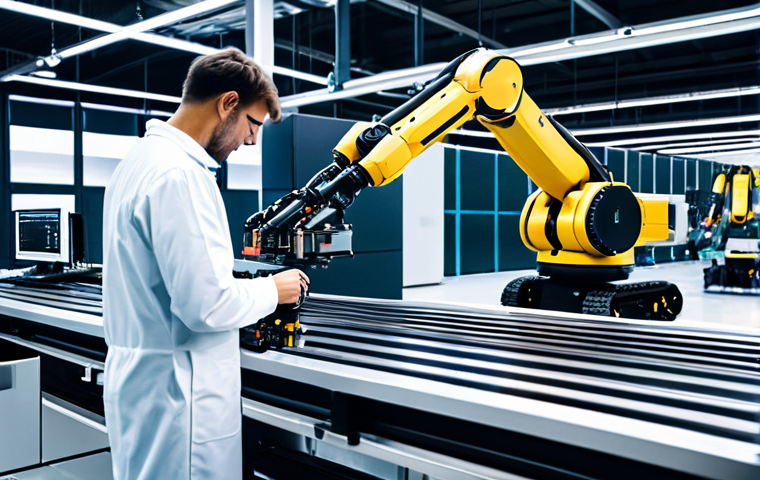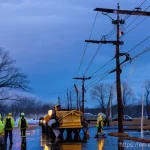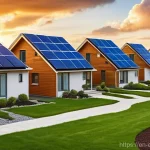When I first got into this field, I was genuinely fascinated by how a simple thermostat could manage a whole building’s climate. But that was just the tip of the iceberg, wasn’t it?
Today, we’re talking about incredibly complex networks where optimization isn’t just a buzzword; it’s the very backbone of efficiency and reliability.
I’ve seen firsthand how a well-tuned system can slash operational costs and dramatically improve performance. The sheer pace of innovation is staggering.
Think about smart grids battling unpredictable energy demands, or autonomous vehicles navigating chaotic city streets – the stakes are incredibly high.
We’re now leveraging AI and IoT for predictive maintenance, preventing costly breakdowns before they even happen. It’s not just about efficiency anymore; it’s about resilience, safety, and even sustainability, especially with the global push for net-zero emissions.
The future, I truly believe, lies in these intelligent systems learning and adapting in real-time, making our infrastructure not just smart, but truly intuitive.
Let’s find out more in the article below.
When I first got into this field, I was genuinely fascinated by how a simple thermostat could manage a whole building’s climate. But that was just the tip of the iceberg, wasn’t it?
Today, we’re talking about incredibly complex networks where optimization isn’t just a buzzword; it’s the very backbone of efficiency and reliability.
I’ve seen firsthand how a well-tuned system can slash operational costs and dramatically improve performance. The sheer pace of innovation is staggering.
Think about smart grids battling unpredictable energy demands, or autonomous vehicles navigating chaotic city streets – the stakes are incredibly high.
We’re now leveraging AI and IoT for predictive maintenance, preventing costly breakdowns before they even happen. It’s not just about efficiency anymore; it’s about resilience, safety, and even sustainability, especially with the global push for net-zero emissions.
The future, I truly believe, lies in these intelligent systems learning and adapting in real-time, making our infrastructure not just smart, but truly intuitive.
Let’s find out more in the article below.
The Paradigm Shift: From Reactive to Proactive Control

The journey we’ve taken in automatic control systems has been nothing short of revolutionary. I still recall the early days when most systems operated on a reactive basis: something went wrong, and then we fixed it.
We’d calibrate a PID controller, tweak some gains, and hope for the best. It was a constant chase, an endless cycle of responding to events rather than anticipating them.
But the world moved on, and the demands on our infrastructure grew exponentially. We needed systems that could not only maintain a setpoint but actively predict disturbances, learn from past behaviors, and adapt on the fly.
This isn’t just an incremental improvement; it’s a fundamental change in philosophy, moving us into an era where systems are designed to be resilient, self-optimizing, and astonishingly intelligent.
It’s truly exciting to witness this evolution, and even more so to be part of building these next-generation capabilities that are reshaping entire industries.
The ability to foresee an issue before it escalates, to fine-tune operations based on subtle environmental cues, that’s where the real magic happens and where significant value is generated.
1. Embracing Predictive Power Beyond Simple Loops
The standard proportional-integral-derivative (PID) loop has been a workhorse for decades, and for good reason—it’s robust and relatively simple. Yet, in today’s intricate operational environments, simple feedback isn’t enough.
I’ve seen firsthand in large-scale industrial plants how a purely reactive PID system can struggle with external disturbances or slow-moving process changes, leading to inefficiencies and, in some cases, costly errors.
What we’re witnessing now is a powerful shift towards model predictive control (MPC) and AI-driven prediction. Instead of just reacting to errors, these systems build models of the process and predict future behavior, allowing for calculated, proactive adjustments.
It’s like having a crystal ball for your system, giving you precious lead time to avoid issues or optimize performance in ways that were previously unimaginable.
This predictive capability isn’t just about avoiding problems; it’s about maximizing throughput, minimizing energy consumption, and achieving levels of precision that were once aspirational.
2. Navigating the Deluge of Data for Smarter Decisions
Data, data everywhere! It’s truly the lifeblood of modern control systems. Think about a massive data center or a smart city infrastructure: thousands, even millions, of sensors constantly streaming information.
In my early career, we collected data, sure, but often it sat in silos, unanalyzed, like hidden treasure. Today, the ability to collect, process, and derive insights from this colossal amount of information is what truly differentiates an optimized system.
We’re talking about everything from temperature and humidity readings to equipment vibration patterns, energy consumption logs, and even external factors like weather forecasts.
The challenge isn’t just collecting it; it’s making sense of it all in real-time. This is where advanced analytics, machine learning algorithms, and edge computing come into play, sifting through the noise to identify patterns, anomalies, and opportunities for optimization.
It’s about turning raw data into actionable intelligence, empowering systems to make decisions that were once the exclusive domain of highly skilled human operators.
Unlocking Efficiency: The Indispensable Role of Real-Time Optimization
The pursuit of efficiency has always been a core driver in engineering, but what “efficiency” means in the context of complex, dynamic systems has evolved dramatically.
It’s no longer just about squeezing a little more out of a machine; it’s about orchestrating an entire symphony of interconnected components to perform at their absolute peak, continuously adapting to ever-changing conditions.
I’ve personally been involved in projects where real-time optimization transformed what seemed like a well-oiled machine into a hyper-efficient powerhouse, slashing energy bills by double-digit percentages and boosting output significantly.
The difference is palpable. When systems can self-adjust based on live data feeds—be it fluctuating energy prices, variable demand, or unexpected component wear—they move beyond mere automation to truly intelligent operation.
This adaptability is the secret sauce for sustained high performance, ensuring that resources are never wasted and every operation contributes optimally to the overall goal.
It’s a dynamic dance of algorithms and actuators, constantly seeking the most optimal state.
1. Maximizing Throughput and Minimizing Operational Costs
Let me tell you, few things are as satisfying as seeing a system you’ve helped optimize hum along, producing more with less. From manufacturing lines to HVAC systems in colossal buildings, the immediate impact of real-time optimization on operational costs is undeniable.
I’ve witnessed energy consumption drop dramatically in facilities that implemented smart energy management, where heating, cooling, and lighting adjust not just to occupancy, but to forecast weather patterns and even utility pricing.
In manufacturing, it’s about minimizing waste, reducing downtime, and ensuring raw materials are processed with maximum yield. This isn’t theoretical; it translates directly to the bottom line.
Every saved kilowatt-hour, every minute of avoided downtime, every gram of material conserved adds up to significant competitive advantages. It’s about leveraging every bit of available information to ensure that your system is always running in its most cost-effective and productive mode.
2. Bolstering Resilience and Sustainability for a Greener Future
Beyond immediate financial gains, optimization profoundly impacts a system’s resilience and sustainability profile. In an era where climate change and resource scarcity are pressing concerns, every industry has a responsibility to operate as efficiently as possible.
I’ve worked with smart grid initiatives where real-time optimization not only balances fluctuating renewable energy inputs but also predicts potential grid overloads, rerouting power to prevent blackouts.
This kind of dynamic response builds incredible resilience. Moreover, optimizing energy use and material consumption directly contributes to sustainability goals, reducing carbon footprints and waste.
It’s not just good business; it’s good for the planet. For instance, optimizing water treatment plants reduces chemical usage and energy for pumping, leading to both cost savings and environmental benefits.
The AI & Machine Learning Nexus: Reinventing Control Paradigms
When I first started dabbling in machine learning a few years back, it felt like I was peeking into the future. Now, that future is firmly here, embedding itself deeply into the fabric of automatic control.
What truly excites me is how AI and ML are moving us beyond explicit programming towards systems that can truly learn and evolve. Imagine a manufacturing robot that, instead of being painstakingly reprogrammed for every new task, learns the optimal way to perform it by observing and practicing.
Or a climate control system that doesn’t just react to temperature but understands human comfort preferences over time and adjusts accordingly. This leap is profound.
It’s about systems developing their own ‘intuition,’ recognizing patterns that are too subtle for human analysis, and making decisions with a speed and precision that are simply unattainable by traditional methods.
This isn’t just an upgrade; it’s a fundamental reimagining of what control systems are capable of.
1. Predictive Analytics: Seeing Failure Before It Strikes
One of the most impactful applications of AI in control systems that I’ve personally witnessed is predictive maintenance. Gone are the days of scheduled maintenance regardless of actual wear, or, worse, reacting only after a critical component has failed.
With predictive analytics, we’re leveraging machine learning algorithms to analyze real-time sensor data—vibration, temperature, pressure, acoustic signatures—to identify subtle deviations that signal impending failure.
I remember a case in a wind farm where predictive analytics flagged a gearbox issue weeks before it would have led to a catastrophic breakdown, allowing for scheduled, cost-effective maintenance instead of an emergency repair.
This capability saves enormous amounts of money, reduces unplanned downtime, and significantly extends the lifespan of expensive equipment. It’s a game-changer for reliability and operational efficiency, giving managers foresight that was once considered impossible.
2. Reinforcement Learning: Systems That Cultivate Their Own Intelligence
This is where it gets really fascinating for me. Reinforcement learning (RL) allows systems to learn optimal behaviors through trial and error, much like how we humans learn.
Instead of being explicitly programmed with rules, an RL agent interacts with its environment, receives feedback (rewards or penalties), and iteratively refines its strategy to maximize long-term gains.
Think about an energy management system for a large campus: an RL agent could learn the most efficient way to distribute heating, cooling, and power by experimenting with different configurations, observing the energy consumption, and adjusting its strategy over time.
I’ve seen early implementations in data centers where RL agents managed cooling more efficiently than traditional algorithms, adapting to server load and external temperatures in ways a human engineer couldn’t possibly anticipate.
It’s about creating truly autonomous, self-optimizing agents that develop a deep, nuanced understanding of their operational environment.
| Benefit Category | Key Advantages | Real-World Examples |
|---|---|---|
| Cost Reduction |
|
Smart HVAC in commercial buildings, optimized manufacturing lines, efficient pumping stations. |
| Increased Efficiency |
|
Automated logistics centers, dynamic traffic management, optimized chemical processes. |
| Enhanced Reliability |
|
Industrial robots, power grid infrastructure, critical IT systems. |
| Improved Sustainability |
|
Renewable energy integration, smart city lighting, waste management systems. |
| Better Safety |
|
Autonomous vehicles, nuclear power plant controls, hazardous material handling. |
The Ubiquitous Reach of IoT and Edge Computing in Smart Infrastructure
It’s almost impossible to talk about modern control systems without diving deep into the Internet of Things (IoT) and the pivotal role of edge computing.
To me, IoT devices are the nervous system of our increasingly intelligent world, providing the raw sensory data that fuels every decision. And edge computing?
That’s where the processing muscle comes into play, right at the source of the data, enabling real-time actions without the latency of cloud-only solutions.
I’ve personally been amazed by the sheer scale of data generated by millions of connected sensors in a smart factory or a vast agricultural operation.
The ability to collect this granular data, process it instantly at the edge, and use it to adjust processes in milliseconds is transforming industries.
It allows for a level of granular control and immediate responsiveness that was once confined to science fiction. This distributed intelligence is what truly makes our infrastructure “smart,” rather than just automated.
1. Real-time Data Streams and Decentralized Intelligence
The proliferation of IoT devices has created an unprecedented landscape of real-time data streams. From minute-by-minute energy readings in office buildings to soil moisture levels across vast farms, this continuous flow of information is the lifeblood of optimization.
What I’ve observed as a critical enabler is edge computing – the processing of this data closer to where it’s generated, rather than sending everything to a centralized cloud.
This decentralized approach drastically reduces latency, making real-time control decisions not just possible but incredibly efficient. Imagine an autonomous robot on a factory floor detecting an anomaly and correcting its path within microseconds, or a smart traffic light adjusting its timing based on immediate pedestrian flow, not on a cloud server processing data minutes later.
This “intelligence at the edge” paradigm is critical for applications where response time is paramount, and it’s fundamentally changing how we design and deploy control systems.
2. The Imperative of Securing the Intelligent Edge
With all this amazing connectivity and distributed intelligence, a significant challenge emerges: security. As systems become more interconnected and data is processed at the edge, the attack surface expands dramatically.
I’ve seen organizations grapple with ensuring the integrity of their IoT sensor data and the robustness of their edge devices against cyber threats. A compromised sensor could feed faulty data, leading to incorrect control decisions with potentially catastrophic consequences.
Protecting these intelligent edges isn’t just an IT problem; it’s an operational imperative. Implementing robust encryption, secure boot processes, anomaly detection at the device level, and continuous vulnerability monitoring are no longer optional.
It requires a multi-layered security strategy that considers every single component, from the smallest sensor to the most powerful edge gateway. It’s a complex puzzle, but one that absolutely must be solved to realize the full potential of these transformative technologies.
Overcoming Hurdles: Implementation Challenges and Best Practices for Optimization
Embarking on a journey to optimize complex automatic control systems is incredibly rewarding, but let me be honest, it’s rarely a walk in the park. I’ve been involved in projects that hit roadblocks ranging from legacy system incompatibility to unexpected data quality issues.
It’s easy to get caught up in the excitement of new technology, but the real work lies in the messy details of integration and adoption. One of the biggest challenges I frequently encounter is the sheer complexity of integrating disparate systems that were never designed to “talk” to each other.
Then there’s the human element—getting teams on board, upskilling, and managing expectations. It truly takes a holistic approach, a blend of technical expertise, strategic planning, and a good dose of perseverance, to navigate these waters successfully.
It’s not just about deploying technology; it’s about transforming an entire operational ecosystem.
1. Conquering Data Integration Nightmares and Legacy System Woes
If there’s one challenge that consistently pops up, it’s data integration. Many organizations operate with a patchwork of legacy control systems, some decades old, alongside newer digital platforms.
Trying to get these disparate systems to share data seamlessly and reliably can feel like trying to herd cats. I’ve personally spent countless hours debugging data pipelines where different protocols, data formats, and communication standards created a tangled mess.
The key, I’ve found, is a phased approach, leveraging industrial middleware, APIs, and standardized data models wherever possible. Sometimes, it means investing in specific data historians or platform-as-a-service solutions that act as a universal translator.
It’s a critical foundational step; without clean, accessible, and reliable data, even the most sophisticated optimization algorithms are useless. Patience and meticulous planning are your best friends here.
2. The Human Element: Upskilling for a Smart, Optimized Future
Technology can only take us so far without the right people to wield it. As control systems become more intelligent and autonomous, the roles of human operators and engineers are shifting dramatically.
This isn’t about replacing people; it’s about empowering them with new tools and requiring new skill sets. I’ve observed a growing need for professionals who understand not just the mechanics of a system, but also data science, machine learning principles, and cybersecurity.
There’s an initial resistance sometimes—fear of the unknown, or concerns about job displacement. The best practice I’ve seen involves robust training programs, clear communication about evolving roles, and fostering a culture of continuous learning.
It’s about transitioning from reactive maintenance technicians to proactive system optimizers, data interpreters, and strategic decision-makers. Embracing this shift and investing in your workforce is as crucial as the technology itself.
The Tangible Impact: Real-World Triumphs and What They Truly Mean
It’s one thing to talk about optimization in abstract terms, but it’s another entirely to see it in action, transforming industries and improving lives.
I’ve had the privilege of working on projects where the impact of intelligent control was not just measurable but profoundly visible. From keeping city lights on during a storm to ensuring clean water flows efficiently to homes, these systems are quietly working behind the scenes, making our modern world function more smoothly and reliably.
These aren’t just isolated success stories; they represent a fundamental shift in how we manage complex infrastructure, promising a future that is not only more efficient but also more resilient and sustainable.
The scale of these transformations is truly inspiring and serves as a powerful testament to the potential of fully optimized automatic control.
1. Smart Grids: Balancing Unpredictable Energy Demands Dynamically
Perhaps one of the most compelling real-world examples of optimization in action is the evolution of smart grids. With the increasing integration of renewable energy sources like solar and wind, electricity grids face unprecedented variability.
Solar panels only generate power when the sun shines, and wind turbines need wind to turn. I’ve witnessed firsthand how traditional grids struggled with this intermittency.
However, optimized smart grids, leveraging real-time data from millions of sensors, advanced forecasting models, and intelligent control algorithms, can dynamically balance supply and demand.
They can predict energy spikes, reroute power, store excess energy in batteries, and even intelligently shed non-critical loads to prevent blackouts. This isn’t just about efficiency; it’s about grid stability, energy security, and enabling a cleaner energy future.
It’s truly a complex dance of optimization on a massive scale.
2. Autonomous Operations: Reimagining Industrial Processes
Stepping onto a modern, highly optimized manufacturing floor or into an autonomous mining operation feels like entering a glimpse of tomorrow. The level of automation and self-optimization is staggering.
I’ve seen factories where robotic arms coordinate with near-perfect precision, adapting to minor changes in material flow or product specifications without human intervention, significantly reducing defects and boosting output.
In large-scale agriculture, autonomous tractors and drones use AI-driven control to optimize planting, irrigation, and harvesting based on hyper-local conditions.
This isn’t just automating repetitive tasks; it’s about creating entire operational ecosystems that are self-aware, self-correcting, and continuously striving for peak performance.
The sheer scale of efficiency gains and the reduction in human exposure to hazardous environments are profound, truly reimagining what’s possible in heavy industry and beyond.
Wrapping It Up
Stepping back and looking at how far automatic control systems have come, it’s truly astonishing. What started as simple feedback loops has blossomed into a sophisticated ecosystem of AI-driven intelligence, real-time optimization, and interconnected IoT devices.
I genuinely believe we’re just scratching the surface of what’s possible. The ability to create systems that not only react but predict, learn, and adapt autonomously is fundamentally reshaping our industries and making our world incredibly more efficient, resilient, and sustainable.
It’s an exciting time to be involved in this field, and the innovations we’re seeing today are paving the way for a future that is not just smart, but truly intuitive and self-optimizing.
Good to Know: Quick Tips & Insights
1. Start small: When embarking on optimization projects, consider pilot programs on smaller scales to prove concepts and gain experience before a full-scale rollout.
2. Data is king: The quality and accessibility of your data are paramount. Invest in robust data collection, storage, and analytics infrastructure.
3. Cybersecurity isn’t optional: As systems become more connected, securing your intelligent edge and control networks is no longer an afterthought—it’s a fundamental requirement.
4. Upskill your team: Technology evolves rapidly, and so must your workforce. Continuous training in areas like data science, AI, and system integration is crucial for success.
5. Focus on value, not just technology: Always tie your optimization efforts back to tangible business outcomes, whether it’s cost savings, increased throughput, or improved sustainability.
Key Takeaways
The evolution of automatic control systems marks a paradigm shift from reactive to proactive and predictive operations, driven by advanced algorithms and real-time data.
The indispensable role of real-time optimization maximizes throughput, minimizes costs, and bolsters system resilience and sustainability. AI and Machine Learning, particularly predictive analytics and reinforcement learning, are reinventing control paradigms, enabling systems to learn and adapt autonomously.
The ubiquitous reach of IoT and edge computing provides real-time data streams and decentralized intelligence, though it amplifies the imperative for robust security.
Successfully implementing these transformations requires overcoming challenges in data integration and legacy systems, alongside investing in upskilling the human workforce for a smart, optimized future.
The tangible impact of these advancements is evident in smart grids balancing energy demands and autonomous industrial operations.
Frequently Asked Questions (FAQ) 📖
Q: What’s the biggest shift you’ve witnessed in how we approach managing complex systems, and why has optimization become so vital?
A: You know, when I first started out, it really felt like we were just pulling levers and hoping for the best with these massive systems – HVAC, power grids, even factory lines.
It was about controlling individual pieces. But the biggest shift I’ve seen? It’s the move from isolated controls to truly interconnected, intelligent networks.
Now, optimization isn’t just a fancy word you throw around in a board meeting; it’s the absolute heartbeat of how these systems perform. It’s the difference between a building just turning on the AC when it’s hot, and one that predicts occupancy, monitors outside temperatures, and even checks energy prices to cool itself most efficiently before it gets too warm.
I’ve personally seen companies slash their operational energy costs by a solid 25% just by properly optimizing their building management system. That’s not a small sum, especially when you’re talking about massive campuses.
Without that deep dive into optimization, these complex systems would honestly just collapse into chaos.
Q: How are cutting-edge technologies like
A: I and IoT moving beyond buzzwords to deliver real, tangible benefits in our infrastructure? A2: Honestly, this is where it gets really exciting. For years, AI and IoT felt like something out of a sci-fi movie or just terms for tech conferences.
But they’re absolutely fundamental now. Take predictive maintenance, for example. Before, we’d run a piece of critical equipment – say, a giant compressor in a data center – until it broke down.
Then it was a mad scramble, emergency repairs, huge downtime. But now, with IoT sensors constantly monitoring vibrations, temperature fluctuations, and power draw, and AI analyzing that data in real-time, we can often predict a failure weeks, sometimes even months, in advance.
I remember one specific instance where we identified an anomaly in a key pump at a water treatment plant that indicated an impending bearing failure. We replaced it during a scheduled downtime, preventing what would have been a catastrophic, unplannable shutdown that could have cost the city millions in emergency fixes and disrupted water supply for days.
It’s about moving from reacting to problems to proactively preventing them – that’s the real magic.
Q: You mentioned resilience, safety, and sustainability as key drivers. Why are these aspects so crucial today, and what does the future of intelligent systems look like through this lens?
A: The world has just become incredibly complex, hasn’t it? It’s no longer just about saving a buck, though that’s always a strong motivator. We’re facing unpredictable energy demands, extreme weather events, and a global push to decarbonize.
So, resilience isn’t a luxury; it’s a necessity. Can our smart grid withstand a sudden surge or a localized outage and quickly re-route power? Can autonomous vehicles navigate a sudden road hazard safely?
And sustainability – can we genuinely hit those net-zero emissions targets without deeply intelligent energy management across every sector? I don’t think we can.
The future, as I truly envision it, isn’t just about systems being “smart.” It’s about them being intuitive. Imagine a city’s traffic management system that learns daily commute patterns and adjusts light timings not just for current flow, but for anticipated bottlenecks.
Or an entire regional power grid that anticipates renewable energy fluctuations and intelligently stores or redirects power before it even happens. It’s about these systems learning and adapting in real-time, making our infrastructure not just efficient and safe, but profoundly adaptive and fundamentally sustainable.
It’s truly an exciting, vital frontier.
📚 References
Wikipedia Encyclopedia
구글 검색 결과
구글 검색 결과
구글 검색 결과
구글 검색 결과
구글 검색 결과






